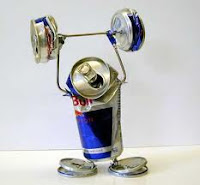 |
| Image 1 (mensfitnessandmore): I would not recommend to empty a whole can of "liquid animals", like bulls or horses, let alone monsters or other popular "creatures" from the kiosk next to your gym, if you don't want to crash from the sudden influx into and as rapid disappearance of sugar from your system - that's by the way what cyclists call "to bonk" and guess what, they do ingest tons of similar sugarwaters and -gels ;-) |
Caffeine is a potent fat liberator and substrate modulator
Given the fact that none of the currently available "fat burners" actively burns body fat, the statistically significant increase in lipolysis, i.e. the release of stored fatty acids into circulation, the increases in peak power, time to exhaustion and overall workout intensity, and the shift towards a higher rate of fatty acid oxidation Olcina et al. observed in their 20 untrained normal weight, young (20.9y), healthy men are not to be sneezed at, though (don't worry about the training status, caffeine is working for trained athletes, as well):
 |
| Figure 1: Performance and cardiovascular parameters during caffeine (5mg/kg) and placebo trial; all significantly (p<0.05) different (data adapted from Olcina. 2012) |
Does caffeine preferentially burn omega-3s and spare saturated fat?
For you as a SuppVersity student, all that ain't really news. What may however surprise you is that the effects of caffeine are not really indiscriminate as far as the type of fatty acids that get burned in the metabolic furnaces of your mitochondria are concerned.
 |
| Figure 2: Respiratory exchange ratio and changes in plasma fatty acid proportions after caffeine (5mg/kg) and placebo trial; all significantly (p<0.05) different (data adapted from Olcina. 2012) |
The increase in saturated fatty acids, on the other reached statistical significance, could however be a simple consequence of the aforementioned caffeine induced increases in lipolysis that was complemented by a proportional increase in stearic acid (C18:0) and a decrease in the mono-unsaturated fatty acid, trans-oleic fatty acid, which could potentially explain previous observations that caffeine reduces the risk of cardiovascular events (van Dam RM. 2008), since lower levels of trans-oleic acid (elaidic acid) show a clear association with increased risk of developing arteriosclerosis (Park. 2009).
Increase your performance, help fat loss - why does it not work for you?
Now all that sounds almost too good to be true. After all, you have been digging caffeine and harder stims for years now and still, you are neither ripped to shreds nor did you win a gold medal at the Olympics, right? Well, the reasons for that are manifold and I cannot possibly name them all in a single blogpost; the worst offenders are yet clearly:
- As far as the issue of "stim tolerance" is concerned, it should still be mentioned that the study subjects consumed caffeine only occasionally and that I highly recommend to take regular times off your favorite pre-workout / stim. Also because the latter contain "other stuff" that does, in combination with caffeine and heavy workouts definitely puts you at a very high risk of overtaxing your sympathetic nervous system. Tired during the day, bad sleep, nightsweats, etc. are all certain signs that you have already passed by your chance to take time off.overtraining on stims and consequent downregulation / impairment of the sympathetic nervous system, often mistaken for "stim tolerance", of which previous allegedly short term (<2 weeks) withdrawl trials have shown that it may exist as far as the immediate and for some nasty side effects are concerned, but not with respect to the performance increases (cf. Van Soeren. 1998, Irwin. 2011)
- not dieting when taking a fat burner so that the fat is simply restored to adipose tissue after its liberation / replaced by fat derived from the energy content of the foods you eat after your workout
- taking too much caffeine either at once or in the course of the day, subsequent chronic overexpression of cortisol, neurotransmitter depletion / irregularities and profound reductions of the testosterone to cortisol ratio (Beavon. 2008); optimal 200-300mg pre-workout (Desbrow. 2012); max. 400mg per dose, max. 600mg per day
- taking caffeine at the wrong time-point, usually too early, will have the plasma levels peak (90-150 min after ingestion; individual differences!), when your workout is long over done (best time to take caffeine for longer workouts is ~60min before exercise; cf. Skinner. 2012)
References
- Beaven CM, Hopkins WG, Hansen KT, Wood MR, Cronin JB, Lowe TE. Dose effect of caffeine on testosterone and cortisol responses to resistance exercise. Int J Sport Nutr Exerc Metab. 2008 Apr;18(2):131-41.
- van Dam RM. Coffee consumption and risk of type 2 diabetes, cardiovascular diseases, and cancer. Appl Physiol Nutr Metab. 2008 Dec;33(6):1269-83.
- Desbrow B, Biddulph C, Devlin B, Grant GD, Anoopkumar-Dukie S, Leveritt MD. The effects of different doses of caffeine on endurance cycling time trial performance. J Sports Sci. 2012;30(2):115-20.
- Irwin C, Desbrow B, Ellis A, O'Keeffe B, Grant G, Leveritt M. Caffeine withdrawal and high-intensity endurance cycling performance. J Sports Sci. 2011 Mar;29(5):509-15.
- Olcina G, Munoz D, Kemp J, Timon R, Maynar J, Caballero MJ, Maynar M. Total plasma fatty acid responses to maximal incremental exercise after caffeine ingestion. J Ex Sci Fi. 2012 June 4 [Epub ahead of print]
- Park Y, Lim J, Kwon Y, Lee J. Correlation of erythrocyte fatty acid composition and dietary intakes with markers of atherosclerosis in patients with myocardial infarction. Nutr Res. 2009 Jun;29(6):391-6.
- Skinner TL, Jenkins DG, Taaffe DR, Leveritt MD, Coombes JS. Coinciding exercise with peak serum caffeine does not improve cycling performance. J Sci Med Sport. 2012 May 31.
- Van Soeren MH, Graham TE. Effect of caffeine on metabolism, exercise endurance, and catecholamine responses after withdrawal. J Appl Physiol. 1998 Oct;85(4):1493-501.
